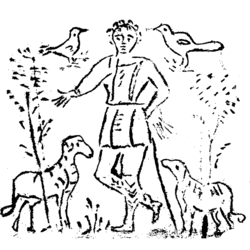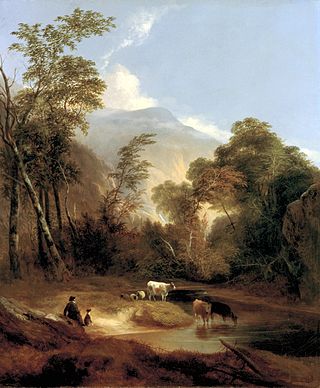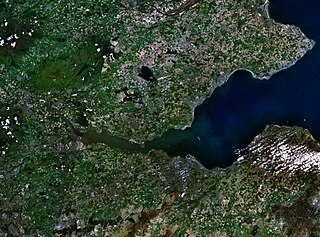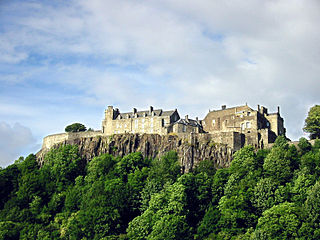
"Robene and Makyne" is a short poem by the 15th-century Scottish makar Robert Henryson. It is an early written example of Scottish pastourelle, derived from the ballad stanza form. [1]

"Robene and Makyne" is a short poem by the 15th-century Scottish makar Robert Henryson. It is an early written example of Scottish pastourelle, derived from the ballad stanza form. [1]

Robene and Makyne (also spelt Mawkin) are stock names for peasant characters, a shepherd and a country maiden. Henryson presents the two characters in the sparest of terms and much in the poem has to be inferred. Strictly speaking, nothing in the text verifies precisely who Makyne might be. In the first half of the poem, she declares longstanding love for Robene, but he is indifferent to her feelings. Minds quickly change and in the closing arc the hopeless declaration is from Robene. This simple dramatic reversal comes at the golden section. Makyne's rejection of Robene is final. [2]
Henryson's writing suggests subtexts around the issue of chastity, a material issue in the late medieval Church and of possible relevance in the poet's own life [ citation needed ]. The spareness allows different and perhaps dissonant readings to be simultaneously present, but any "allegorical" implications are present without pretentiousness or loss of authentic feeling and the poem stands as a simple comic creation with a surprisingly wide range of emotion and intriguing tonal ambiguity [ citation needed ].
The closure, peculiar in its effect, evokes feelings of emptiness and a sense of musical return. [3]
Stanzas 12 and 13 of "Robene and Makyne," where the first stanza is spoken by Makyne, followed by Robene:

The pastoral genre of literature, art, or music depicts an idealised form of the shepherd's lifestyle – herding livestock around open areas of land according to the seasons and the changing availability of water and pasture. The target audience is typically an urban one. A pastoral is a work of this genre. A piece of music in the genre is usually referred to as a pastorale.
Rhyme royal is a rhyming stanza form that was introduced to English poetry by Geoffrey Chaucer. The form enjoyed significant success in the fifteenth century and into the sixteenth century. It has had a more subdued but continuing influence on English verse in more recent centuries.

Robert Henryson was a poet who flourished in Scotland in the period c. 1460–1500. Counted among the Scots makars, he lived in the royal burgh of Dunfermline and is a distinctive voice in the Northern Renaissance at a time when the culture was on a cusp between medieval and renaissance sensibilities. Little is known of his life, but evidence suggests that he was a teacher who had training in law and the humanities, that he had a connection with Dunfermline Abbey and that he may also have been associated for a period with Glasgow University. His poetry was composed in Middle Scots at a time when this was the state language. His writing consists mainly of narrative works. His surviving body of work amounts to almost 5000 lines.
Middle Scots was the Anglic language of Lowland Scotland in the period from 1450 to 1700. By the end of the 15th century, its phonology, orthography, accidence, syntax and vocabulary had diverged markedly from Early Scots, which was virtually indistinguishable from early Northumbrian Middle English. Subsequently, the orthography of Middle Scots differed from that of the emerging Modern English standard. Middle Scots was fairly uniform throughout its many texts, albeit with some variation due to the use of Romance forms in translations from Latin or French, turns of phrases and grammar in recensions of southern texts influenced by southern forms, misunderstandings and mistakes made by foreign printers.
"The Baffled Knight" or "Blow Away the Morning Dew" is a traditional ballad existing in numerous variants. The first-known version was published in Thomas Ravenscroft's Deuteromelia (1609) with a matching tune, making this one of the few early ballads for which there is extant original music. The song was included in such notable collections as Pills to Purge Melancholy by Thomas d'Urfey (1719–1720) and Reliques of Ancient English Poetry by Thomas Percy (1765).
Chaucer's influence on 15th-century Scottish literature began towards the beginning of the century with King James I of Scotland. This first phase of Scottish "Chaucerianism" was followed by a second phase, comprising the works of Robert Henryson, William Dunbar, and Gavin Douglas. At this point, England has recognised Scotland as an independent state following the end of the Wars of Scottish Independence in 1357. Because of Scottish history and the English’s recent involvement in that history, all of these writers are familiar with the works of Geoffrey Chaucer.

The Morall Fabillis of Esope the Phrygian is a work of Northern Renaissance literature composed in Middle Scots by the fifteenth century Scottish makar, Robert Henryson. It is a cycle of thirteen connected narrative poems based on fables from the European tradition. The drama of the cycle exploits a set of complex moral dilemmas through the figure of animals representing a full range of human psychology. As the work progresses, the stories and situations become increasingly dark.
Matthew Purdie McDiarmid was a Scottish literary scholar, essayist, campaigning academic and poet. He was a founding member of the Association for Scottish Literary Studies (1970) and the first president of the Robert Henryson Society which he also helped to found in 1993.

"The Taill of the Uponlandis Mous and the Burges Mous", also known as "The Twa Mice," is a Middle Scots adaptation of Aesop's Fable The Town Mouse and the Country Mouse by the Scottish poet Robert Henryson. Written around the 1480s, it is the second poem in Henryson's collection called The Morall Fabillis of Esope the Phrygian.

The Bannatyne Manuscript is an anthology of literature compiled in Scotland in the sixteenth century. It is an important source for the Scots poetry of the fifteenth and sixteenth centuries. The manuscript contains texts of the poems of the great makars, many anonymous Scots pieces and works by medieval English poets.

"The Taill of the Cok and the Jasp" is a Middle Scots version of Aesop's Fable The Cock and the Jewel by the 15th-century Scottish poet Robert Henryson. It is the first in Henryson's collection known as the Morall Fabillis of Esope the Phrygian. The Cok and the Jasp is framed by a prologue and a moralitas, and as the first poem in the collection it operates on a number of levels, and in all its parts, to introduce the larger cycle.

"The Taill of Schir Chanticleir and the Foxe" is Fabill 3 of Robert Henryson's cycle of thirteen Morall Fabillis composed in Scotland in the later fifteenth century. It is the first of the fable in the poem to be based on Reynardian and beast epic sources rather than on any strictly Aesopian original, although the closest match from Aesop might be The Dog, the Cock and the Fox.

That part of the United Kingdom called Northern Ireland was created in 1922, with the partition of the island of Ireland. The majority of the population of Northern Ireland wanted to remain within the United Kingdom. Most of these were the Protestant descendants of settlers from Great Britain.
William Stewart was a Scottish poet working in the first half of the 16th century.

Ane Ballat of the Fenyeit Frier of Tungland, How He Fell in the Myre Fleand to Turkiland is a comic, satirical poem in Scots by William Dunbar composed in the early sixteenth century. The title may be rendered in modern English as A Ballad of The False Friar of Tongland, How He Fell in the Mire Flying to Turkey.

Remonstrance to the King is a Scots poem of William Dunbar composed in the early sixteenth century. The Remonstrance is one of Dunbar's many appeals to his patron James IV of Scotland asking for personal advancement. In this particular case, the unseemly personal pleading is combined with more dignified subject matter; lavish praise and pointed criticism of the King's court is delivered in an open manner.
"Quhy Sowld Nocht Allane Honorit Be" is an anonymous allegorical poem of the fifteenth or sixteenth century written in Scots.

The Thrissil and the Rois is a Scots poem composed by William Dunbar to mark the wedding, in August 1503, of King James IV of Scotland to Princess Margaret Tudor of England.

Scots-language literature is literature, including poetry, prose and drama, written in the Scots language in its many forms and derivatives. Middle Scots became the dominant language of Scotland in the late Middle Ages. The first surviving major text in Scots literature is John Barbour's Brus (1375). Some ballads may date back to the thirteenth century, but were not recorded until the eighteenth century. In the early fifteenth century Scots historical works included Andrew of Wyntoun's verse Orygynale Cronykil of Scotland and Blind Harry's The Wallace. Much Middle Scots literature was produced by makars, poets with links to the royal court, which included James I, who wrote the extended poem The Kingis Quair. Writers such as William Dunbar, Robert Henryson, Walter Kennedy and Gavin Douglas have been seen as creating a golden age in Scottish poetry. In the late fifteenth century, Scots prose also began to develop as a genre. The first complete surviving work is John Ireland's The Meroure of Wyssdome (1490). There were also prose translations of French books of chivalry that survive from the 1450s. The landmark work in the reign of James IV was Gavin Douglas's version of Virgil's Aeneid.
Ane Dance in the Quenis Chalmer or A dance in the Queen's chamber is a humorous or satiric Scots poem by William Dunbar.